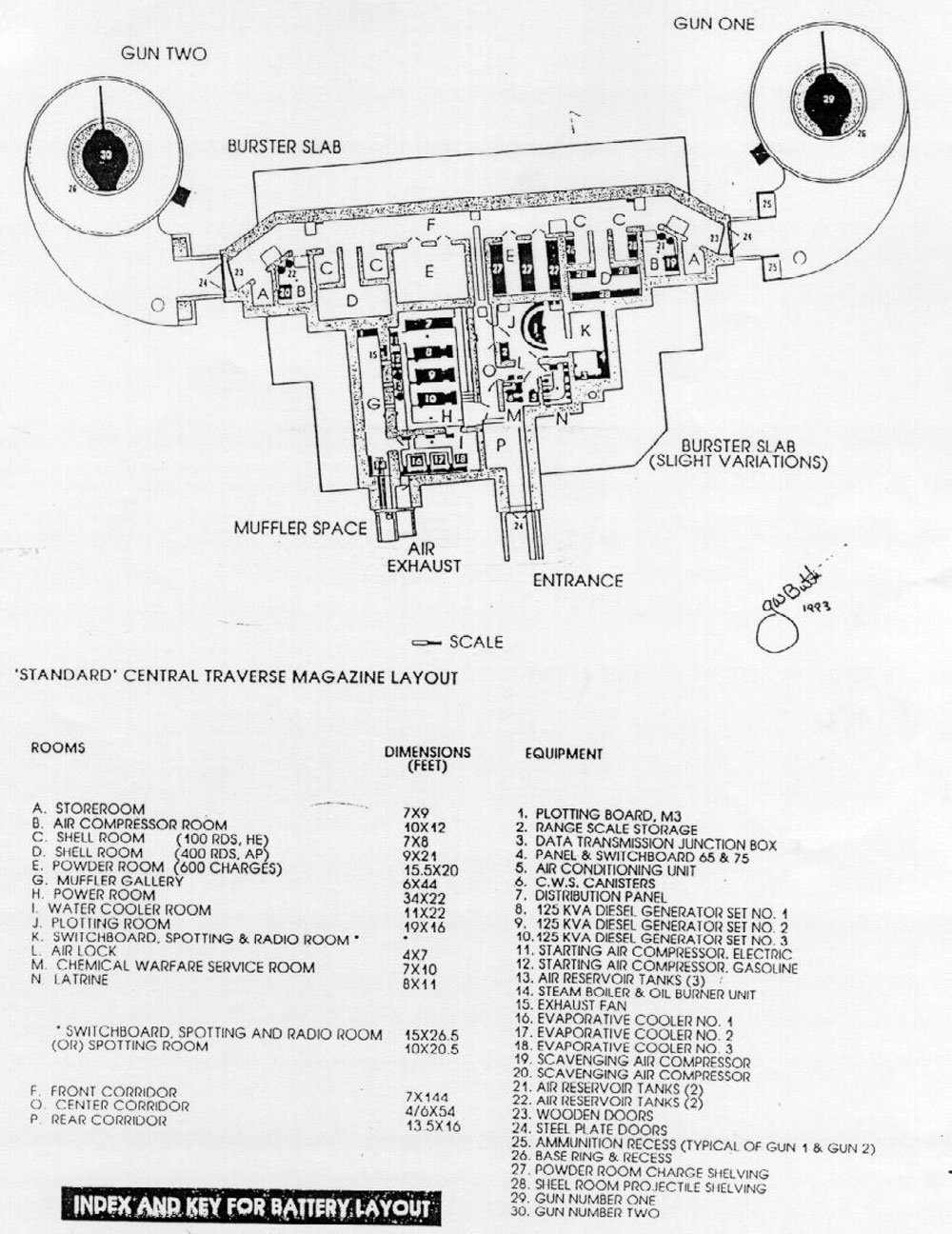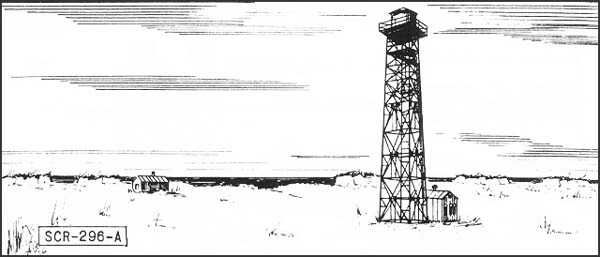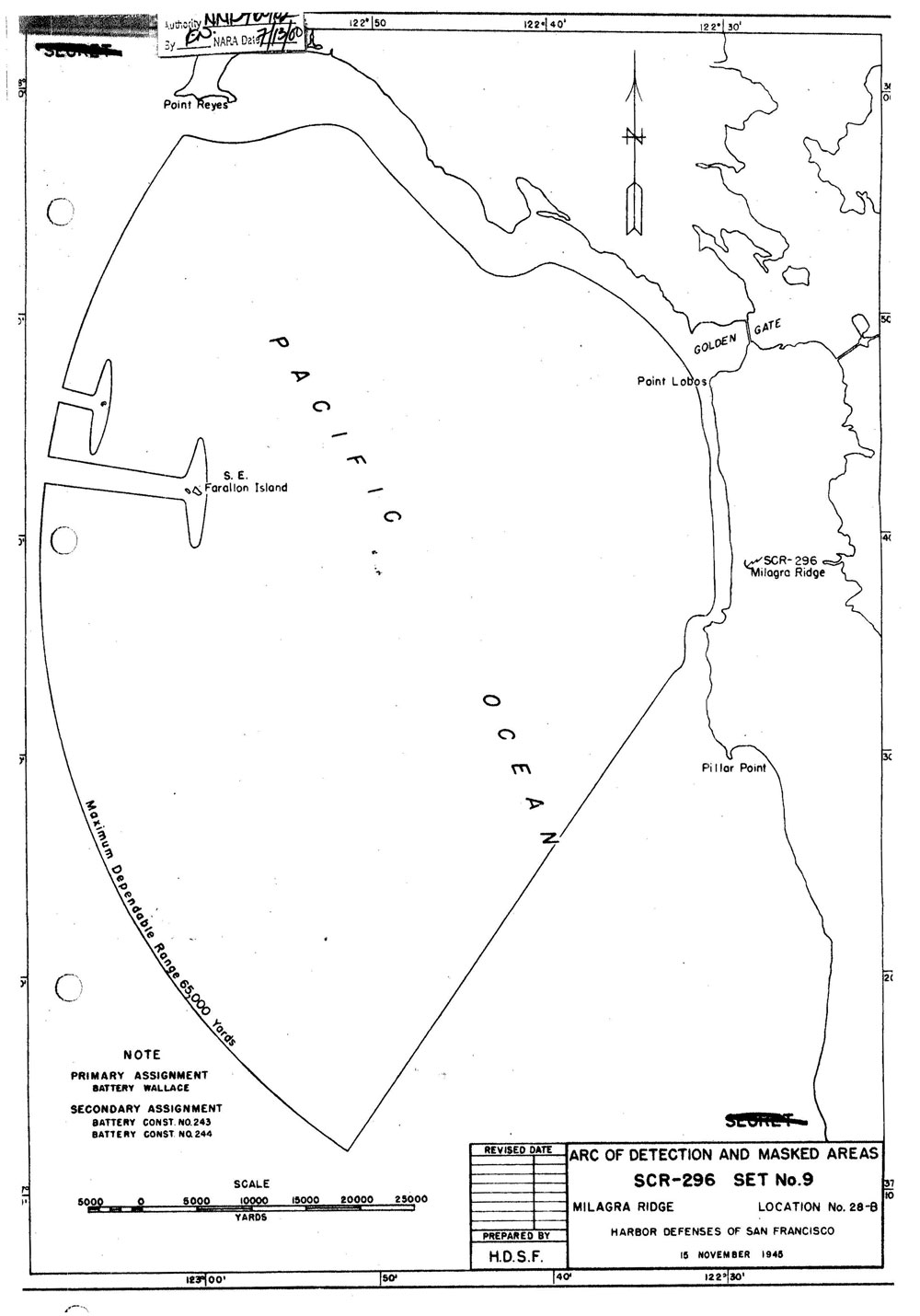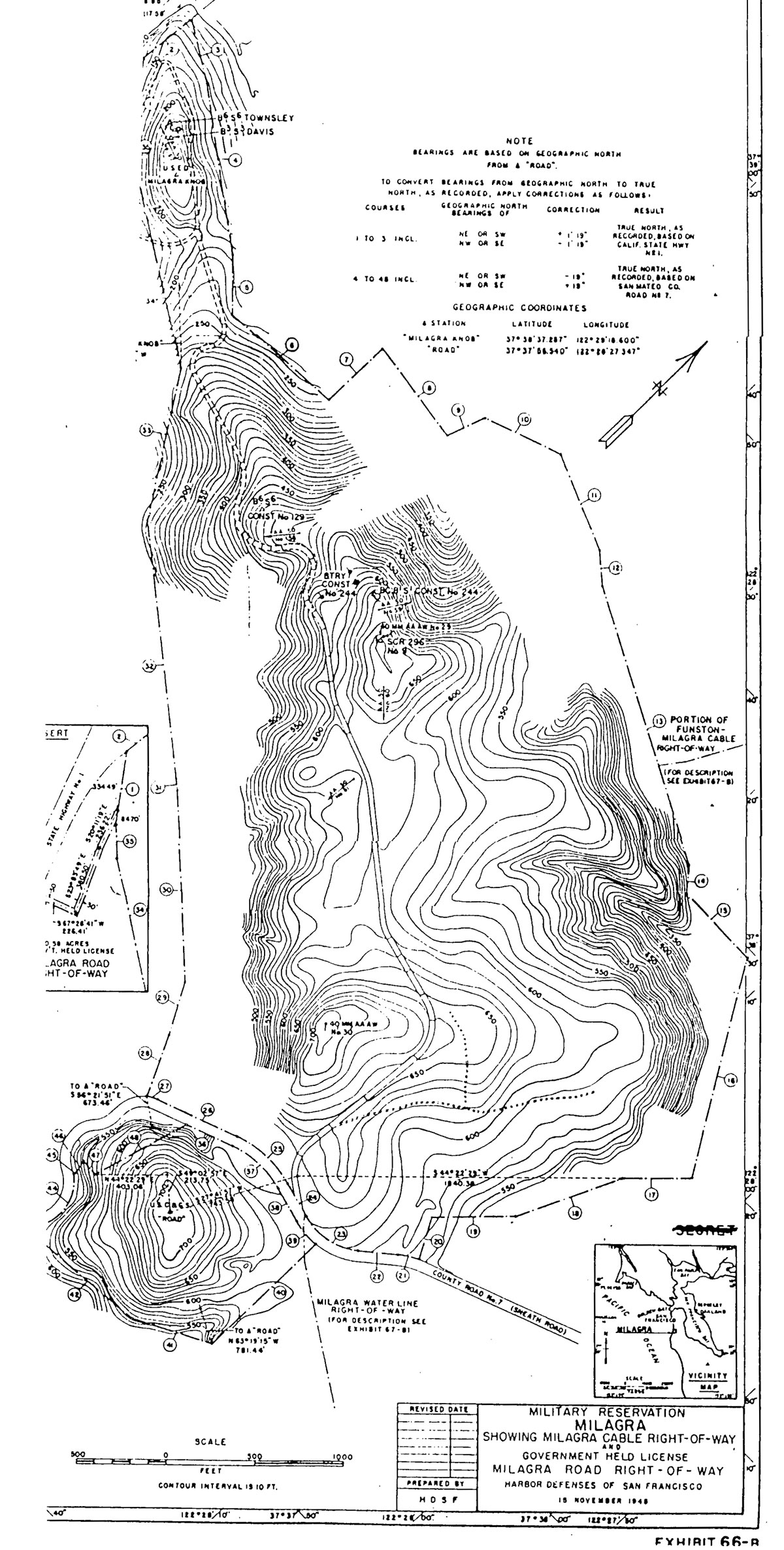-
- Historic California
Posts, Camps Stations and Airfields
- Milagra Military Reservation
- (San Francisco Defense Area Site
SF-51, less Integrated Fire Control Site (SF-51C]; Battery Construction
Nos. 130 and 244, SCR-296 Radar Set No. 9)
-
Now a part of the Golden Gate National Recreation Area (GGNRA),
Milagra Ridge was the southern-most coastal defense work built
to defend the entrance to San Francisco Bay. A 6" gun emplacement
was built here during World War II. A 16" gun emplacement
similar to one at Fort Funston was to be built but it was canceled.
Later, the area was used as a launch site for a Nike missile
battery. The deserted Battery 244 several fire control stations
and the buried Nike bunkers remain at this undeveloped park.
-
- Source: Mark J. Berhow
-
- History
- by Sgt. Maj. (CA) Dan Sebby, Military
Historian, California Military Department
-
- On 14 June 1940, the U.S. Army acquired
5.521 acres of land to establish a cable landing and fire control
stations for Fort Cronkhite's Battery Townsley, Fort Barry's
Battery 129 and Fort Funston's Battery Richmond P. Davis. A fire
control station for Milagra Ridge's Battery 244 was also on the
reservation. Connecting these fire control stations to the headquarters
at Fort Winfield Scott and other harbor defenses was a waterproof
telephone cable that ran offshore and came ashore at the Site.
There was also a small power plant (Building 234) that provided
electrical service to these fire control stations.
From 14 June 1942 until 3 June 1943, the U.S. Army acquired an
additional 322.45 acres through direct purchase and Federal condemnation
process. Construction on the fortified Battery Construction No.
244 began in 1943 and was completed in 1944. However, the two
6-inch rifles previously located at Fort Columbia, Wash., were
not mounted until 1948. The removal of these two guns in 1950
marked the end of static fortifications defending the San Francisco
Bay (Golden Gate National Recreation Area 1999).
-
-

The T2M1 6-inch Rifle mounted
on the M4 Shielded Long Range Barbette Carriage as used at Battery
Construction No. 244.
-
- Also located at the Site during World
War II and the immediate post-war period was an SCR-296 radar
set which provided additional fire control data to the Harbor
Defenses of San Francisco. It was located on top of the hill
to the southeast of Battery Construction 244. The Site was also
defended from aircraft by two M1 40mm mobile antiaircraft guns
(positions number 29 and 30) and five 0.50-caliber antiaircraft
guns (http://www.cdsg.org, 2005).
In addition to Battery Construction No. 244, there was a plan
to build a battery that would have mounted two 16-inch rifles
known as Battery Construction No. 130. However, World War II
ended before construction on the battery could begin. An additional
fire control station for Fort Barry's Battery Construction No.
129 was also built during World War II to the northwest of Battery
Construction No. 244.
After the disarming of Battery Construction No. 244, the Site
became an inactive installation. According to audited USACE real
estate maps, the Site was transferred to the U.S. Navy 31 October
1951 in what appears to be a large transfer of land between the
two services. However, the Site was removed from the transfer
by the Secretary of the Army on 28 November 1952.
In 1956, the U.S. Army established an air defense missile site
on the Site officially known as San Francisco Defense Site SF-51.
As with all U.S. Army Air defense missile sites of this period
the missile battery was divided into three functional areas.
The Administrative Area (SF-51A) contained the Site's administrative
and support functions. This included troop housing and messing,
recreational facilities, battery administration, supply buildings,
and vehicle maintenance facilities. The buildings were of a standard
concrete block construction and were heated by fuel oil (Morgan
and Berhow 2002).
-
%20F.jpg)
- Administrative Area
(SF-51A) circa 1958
The Control Area (SF-51C, also known as the Integrated Fire Control
area) was the location of the Site's radar and fire control systems.
The Control Area was located 1-1/2 miles to the southeast on
Sweeney Ridge and allowed for 360-degree "line-of-site"
radar coverage by the Site's tracking and search radar systems.
The missile tracking radar would "lock-on" to the missiles
as they sat on the launcher and follow them from launch to impact
with the target. The Control Area was located away from the Launcher
Area because the high speed of the Nike missiles would have destroyed
the mechanisms of the missile tracking radar. SF-51C is reported
separately under a separate history.
The Launcher Area (SF-51L) was located adjacent to and northwest
of the Administrative Area and consisted of 8 launchers and 2
magazines (also known as underground storage "bunkers")
that held a total of 20 MIM-3 Nike-Ajax multi-stage, surface-to-air
missiles. The Nike-Ajax missile required facilities for the fuelling
of the Ajax (second-stage) portion of the missile. The liquid
fuel used for the Ajax was a combination of dimethyl hydrazine
and red fuming nitric acid. The Nike portion (booster or first-stage)
used a solid fuel which did not require on-site fueling. The
magazines were modified from May 1958 to April 1959 to hold 12
of the larger MIM-14 Nike-Hercules missiles. The Nike-Hercules
missile used a much safer solid fuel for both stages. The Nike-Hercules
missile could be armed with either a high explosive or nuclear
warhead. Additionally, the Launcher Area also consisted of missile
and warhead assembly, crew readiness, and security buildings.
(Morgan and Berhow 2002).
The Site was garrisoned by the U.S. Army's Battery C, 740th Antiaircraft
Artillery Missile Battalion (1956 through September 1958); Battery
C, 4th Missile Battalion, 61st Artillery Regiment (September
1958 through July 1959); and Battery D, 2nd Missile Battalion,
51st Artillery Regiment (July 1959 through June 1963). The California
Army National Guard's Battery A, 1st Missile Battalion, 250th
Artillery Regiment (1st California) (After 1966, Battery A, 1st
Battalion (Nike-Hercules), 250th Air Defense Artillery Regiment
(1st California)) garrisoned the Site from June 1963 until April
1974 when the garrison was inactivated and the Site was deactivated
(Morgan and Berhow 2002).
-
-
- 1940 Program
and World War II Temporary
-
|
Battery Name |
Number of Guns |
Type of Gun |
Type of Carriage |
Constructed |
Completed |
Decommissioned |
|
Battery
Construction 244 |
2 |
6 inch T2M1 |
Shielded Long Range Barbette
M4 |
1942 |
1947 |
1950 |
|
Battery
Construction 130 |
2 |
16 inch |
Casemated Long Range Barbette |
Not Built |
- |
- |
-
-
- Battery Construction
No. 244
- by Justin M. Ruhge
-
- Construction 244 was located on Milagra
Ridge south of Fort Funston and behind the town of Pacifica.
Like its counterpart at Fort Miley, Construction 243, it was
started late in 1943 and not completed by the end of World War
II. Construction 244 consisted of two 6-inch breech-loading rifles
on barbette mounts surrounded with a two-inch thick steel shield.
The two guns were 200 feet apart and separated by an earth-covered
concrete magazine and plotting and control rooms.
-
- Milagra Ridge was a site planned for a
second 16-inch battery designated Construction 130, which was
not started.
-
- During World War II fire control stations
and radar installations were located on the remote ridge.
-
- After the war Construction 244, which
had been completed, was like 243 turned over to the Navy. The
Navy was newly designated as the protector of the minefields.
Construction 244 was kept in the service for that purpose until
about 1950 when the minefields and the gun batteries were considered
obsolete.
-
- BCN-200-Series
Battery Layout
-

- An
Artist's Rendering of a Standard Two Gun 6-Inch Battery Showing
Layout Details. Artwork by Gerald W. Butler.
Taken From of 1940 by Robert D. Zink, The Six-Inch
Part of the Modernization Program, Coast Defense Study Group Journal, Vol. 8, No.
2, pgs. 21-39, May 1994.
-
-
-
- SCR-296 Radar
Set No. 9 Supporting Battery 244
-

- Typical installation
of an SCR-296 radar set.
| Description: |
Fixed Coast
Artillery gun-laying medium wave radar, assigned to modern 6
inch or larger batteries. |
| Uses: |
Set is designed
to track a surface target in range and azimuth. Data are sent
to the plotting room and used in firing. An SCR-296-A normally
is assigned to one battery, but may furnish data to more. Works
with IFF RC-136-A. |
| Performance
& Sitting: |
Range is shown
on "A" scope. The target is tracked in azimuth with
a pip matching oscilloscope or a zero-center meter. Range accuracy
is about ± 30 yards while azimuth accuracy is about ±
0.20 degree under the best conditions. The set has a dependable
range of 20,000 yards on a destroyer size target when employed
at a height of 145 feet. Site should be not less than 100 feet
above sea level; 150 to 500 feet is recommended. |
| Mobility: |
Shipment includes
areas and separate generator. When crated the total weight is
91,763 lbs. Largest unit is 5,270 lbs. |
| Installation: |
SCR-296-A includes
a tower, an operating building, and two power plant buildings.
The tower is obtainable in heights of 25, 50, 75, and 100 feet.
Concrete floors must be put in locally. |
| Personnel: |
Operating crew
consists of 5 men in addition to a power plant operator and maintenance
man who should be available at all times. |
| Power: |
Primary power
of 2.3 KW is supplied by PE-84C -- commercial or auxiliary 110
V, AC single phase. Generator needs high octane gasoline. |
| |
Information from
Naval
History Library Online. |

Report of
Completed Works - Seacoast Fortifications: SCR-296 Seacoast Radar
Set No. 9
-
- San Francisco
Defense Area SF-51
- by Sacramento District, US Army Corps
of Engineers
The Milagra Ridge Military Reservation (Nike
Site SF-51L) is situated approximately seven miles south of San
Francisco in Pacifica, San Mateo, CA. The total acreage was 330.01.
There were 327.97 fee acres, 0.58 license acres, and 1.46 easement
acres. The site was acquired in 1942.
The Milagra Ridge Military Reservation site
was originally used for coastal defense purposes, fire control
station, and most recently as a launcher and administrative area
of Nike Site SF-51. This site was used by the U.S. Army Air Defense
Command.
Between July 11, 1946 and May 10, 1962,
73.11 acres were disposed of. Of the remaining 256.90 acres, a
portion of Nike Site SF-51 (36.48 acres) was declared excess in
1972 and was transferred to the Department of the Interior, and
subsequently transferred to the City of Pacifica in May 1974.
The U.S. retained 220.42 acres. The 73.11 acres disposed of in
1962 are currently privately held: 28.79 acres are in residential
development and 44.32 acres are under development.
- The Nike-Ajax
and Nike-Hercules Missiles
- The Western Electric SAM-A-7/M1/MIM-3
Nike Ajax
The Nike Ajax was the world's first
operational surface-to-air guided missile system. Its origins
lay in the immediate post-war time, when the U.S. Army realized
that guided missiles were the only way to provide air-defense
against future fast high-flying bombers. Western Electric became
the prime contractor for the XSAM-G-7 Nike missile system
and Douglas as the primary subcontractor was responsible for the
missile airframe.
The first unguided Nike missiles
were fired in 1946, but problems with the original multi-rocket
booster (eight solid-fuel rockets wrapped around the missile tail)
soon led to delays in the program. In 1948, it was decided to
replace this booster pack with a single rocket booster, attached
to the back of the missile. The main propulsion of the missile
was a Bell liquid-fueled rocket motor, and the flight path was
controlled by the four small fins around the nose. In November
1951, the first successful interception of a QB-17 target drone
succeeded. The first production Nike (which had been redesignated
SAM-A-7 in 1951) flew in 1952, and the first operational Nike
site was activated in 1954. By this time, the missile had been
designated by the Army as Guided Missile, Anti-Aircraft M1. The
name had changed to Nike I, to distinguish it from the
Nike-B (later MIM-14 Nike Hercules) and Nike II
(later LIM-49 Nike Zeus). On 15 November 1956, the name was finally
changed to Nike Ajax.
The Nike Ajax missile used a command
guidance system. An acquisition radar called LOPAR (Low-Power
Acquisition Radar) picked up potential targets at long range,
and the information on hostile targets was then transferred to
the Target Tracking Radar (TTR). An adjacent Missile Tracking
Radar (MTR) tracked the flight path of the Nike Ajax missile.
Using tracking data of the TTR and MTR, a computer calculated
the interception trajectory, and sent appropriate course correction
commands to the missile. The three high-explosive fragmentation
warheads of the missile (in nose, center, and aft section) were
detonated by ground command, when the paths of target and missile
met.
One of the major disadvantages of the Nike
Ajax system was that the guidance system could handle only
one target at a time. Additionally, there was originally no data
link between different Nike Ajax sites, which could lead
to several sites engaging the same target. The latter problem
was eventually solved by the introduction of the Martin AN/FSG-1
Missile Master command-and-control system, with automatic
data communication and processing. Other problematic features
of the Nike Ajax system were the liquid-fuel rocket motor
with its highly toxic propellants, and the large size of a complete
site with all components, which made Nike Ajax to all intents
and purposes a fixed-site air defense system.
By 1958, nearly 200 Nike Ajax sites
had been activated in the United States. However, the far more
advanced MIM-14 Nike Hercules soon replaced the Nike Ajax,
and by late 1963, the last Nike Ajax on U.S. soil had been
retired. In 1963, the Nike Ajax had received the new designation
MIM-3A. Despite the use of an MIM (Mobile Intercept Missile) designator,
the mobility of the Nike Ajax system was more theoretical
than actually feasible in a combat situation.
The MIM-3A continued to serve with U.S.
overseas and friendly forces for many more years. In total, more
than 16,000 missiles were built.

- Nike Ajax and Nike
Hercules Missiles (NARA)
-
Western Electric SAM-A-25/M6/MIM-14 Nike
Hercules
The Nike Hercules was the only nuclear-armed
surface-to-air weapon, which was operational with the U.S. Army.
Development of an improved Nike missile began in 1952, with the
primary goal to develop a missile with a significantly higher
performance than MIM-3 Nike Ajax (then known simply as
Nike), which could still be used with the existing Nike
ground equipment. After it had been shown that the Nike Ajax
could not be equipped with then existing nuclear warheads, nuclear
armament became another goal for the new missile. The SAM-A-25
Nike B program was formally established in June 1953. As with
Nike Ajax, Western Electric was prime contractor, and Douglas
was responsible for the missile airframe.
The Nike B (renamed Nike Hercules
on 15 December 1956) used many components of the Nike I
(Nike Ajax). The booster consisted of four Nike Ajax
boosters, and the original design used 4 of Ajax' liqued-fuel
rockets as sustainer propulsion. However, the first flight tests
with the liquid-fuel sustainer in 1955 proved very troublesome,
and a solid-fueled sustainer rocket was eventually used. The first
successful interception of a drone target occurred in 1956, and
in 1957 the new solid-fuel sustainer flew for the first time.
Nike Hercules used the same command guidance as the MIM-3
Nike Ajax, with essentially the same ground components.
The first production Nike Hercules
missiles were delivered in 1958, and quickly replaced the Ajax
on many Nike sites. By then, the Nike Hercules had
been designated as Guided Missile, Air Defense M6. The M6 could
be equipped with either an M17 (a.k.a. T45) blast-fragmentation
warhead, or a W-31 nuclear fission warhead with yield selectable
as 2 kT or 40 kT. The missile performance was such that even very
high-flying bombers could not escpe the Nike Hercules.
Capability against low-level targets remained rather limited,
however.
As the Nike Hercules began replacing
the older Nike Ajax, work was underway to improve the acquisition
and tracking radar capabilities to fully exploit the missile's
greater performance. The major improvement in what was called
the Improved Hercules system was the new L-band acquisition
radar, called HIPAR (High-Power Acquisition Radar). The TTR (Target
Tracking Radar) and TRR (Target Ranging Radar) were also improved,
having better ECM resistance. The missiles of the improved Improved
Hercules system were designated as M6A1. In June 1960, an Improved
Hercules achieved the world's first successful interception of
a ballistic guided missile, when a MGM-5 Corporal SRBM was shot
down. The new radars were also far more compact than the original
ones, which made moving a Nike site a least somewhat practical
for the first time. Lastly, Improved Hercules introduced
a viable surface-to-surface capability to the Nike system.
The first Improved Hercules systems were installed at Nike
sites in June 1961.
In 1963, the M6 and M6A1 missiles were redesignated
as MIM-14A and MIM-14B, respectively. The MIM-14C (introduced
in 1972) was a modified MIM-14B with an improved missile guidance
section for higher manoeuverability and better ECM resistance.
All in all, the U.S. Army established 145
Nike Hercules sites over the years. Production of the nuclear-armed
missiles ended in 1964, and gradual phase-out of the MIM-14 began
in the late 1960's. The Army originally planned to replace the
Nike with the new MIM-104 Patriot missile, but this
plan was not implemented in the USA. Therefore, after the last
active Nike Hercules sites in the continental U.S. had
been deactivated in 1974, there are no long-range air-defense
missiles fielded in the U.S.. In Europe, the U.S. Army retired
its last MIM-14 units in 1984, when the MIM-104 Patriot
was introduced.
- In total, more than 25,000 Nike Hercules
missiles of all wersions were produced, most being of the MIM-14B
variant.
- Source: Directory of U.S. Missiles
and Rockets, http://www.designation-systems.net/
-
-
- Report of
Completed Works - Seacoast Fortifications
-

-
- Reports
of Completed Works - Seacoast Fortifications: Milagra Military
Reservation
-
-
- Site Map
-

-
- Reports
of Completed Works - Seacoast Fortifications: Milagra Ridge Military
Reservation
-
-
- Additional
Online Information
-
- Wikipedia
- Fort Wiki
- National Park Service
- Harbor Defenses of San Francisco - A Field Guide
1890 to 1950
- The
Six-Inch Part of the Modernization Program
-
Updated 13 October 2015
%20F.jpg)





